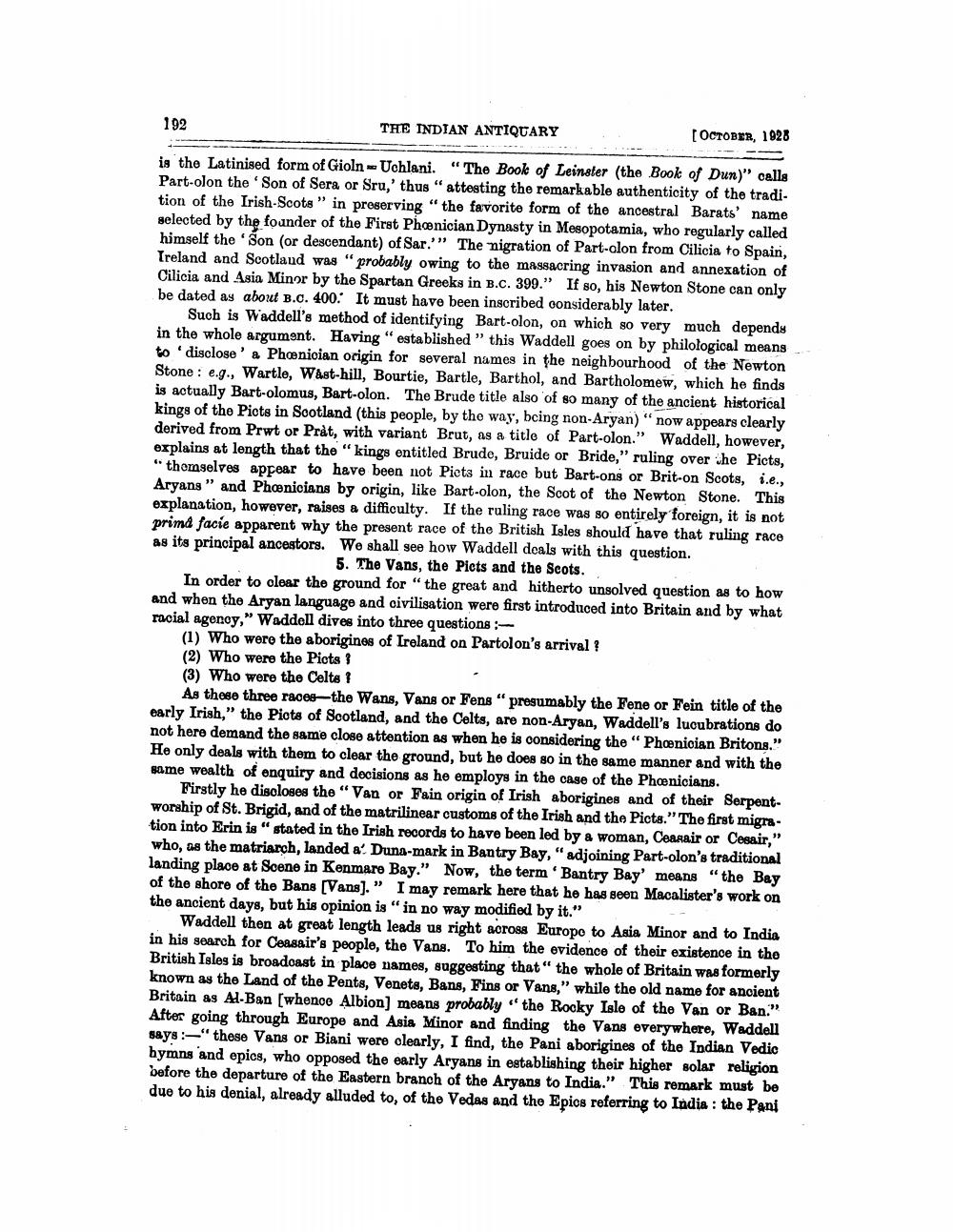________________
192
THE INDIAN ANTIQUARY
[OCTOBER, 1028
is the Latinised form of Gioln Uchlani. “The Book of Leinster (the Book of Dun)" cells Part-olon the 'Son of Sera or Sru,' thus" attesting the remarkable authenticity of the tradition of the Irish-Scots" in preserving "the favorite form of the ancestral Barats' name selected by the founder of the First Phænician Dynasty in Mesopotamia, who regularly called himself the Son (or descendant) of Sar."" The nigration of Part-olon from Cilicia to Spain, Ireland and Scotland was "probably owing to the massacring invasion and annexation of Cilicia and Asia Minor by the Spartan Greeks in B.C. 399.” If so, his Newton Stone can only be dated ay about B.C. 400. It must have been inscribed considerably later.
Such is Waddell's method of identifying Bart-olon, on which so very much depends in the whole argument. Having "established" this Waddell goes on by philological means to disclose' & Phoenician origin for several names in the neighbourhood of the Newton Stone : e.g., Wartle, Wast-hill, Bourtie, Bartle, Barthol, and Bartholomew, which he finds is actually Bart-olomus, Bart-olon. The Brude title also of so many of the ancient historical kings of the Picts in Scotland (this people, by the way, being non-Aryan)" now appears clearly derived from Prwt or Pràt, with variant Brut, as a title of Part-olon." Waddell, however, explains at length that the "kings entitled Brude, Bruide or Bride," ruling over he Picts, "themselves appear to have been not Picts in race but Bart-ons or Brit-on Scots, i.e., Aryang" and Phoenicians by origin, like Bart-olon, the Soot of the Newton Stone. This explanation, however, raises a difficulty. If the ruling race was so entirely foreign, it is not prima facie apparent why the present race of the British Isles should have that ruling race as its principal ancestors. We shall see how Waddell deals with this question.
5. The Vans, the Picts and the Scots. In order to clear the ground for "the great and hitherto unsolved question as to how and when the Aryan language and civilisation were first introduced into Britain and by what racial agenoy," Waddell dives into three questions :
(1) Who were the aborigines of Ireland on Partolon's arrival ! (2) Who were the Piots ? (3) Who were the Celts ?
As these three races-the Wans, Vans or Fens "presumably the Fene or Fein title of the early Irish," the Piots of Scotland, and the Celts, are non-Aryan, Waddell's lucubrations do not here demand the same close attention as when he is considering the "Phoenician Britons." He only deals with them to clear the ground, but he does so in the same manner and with the same wealth of enquiry and decisions as he employs in the case of the Phoenicians.
Firstly he discloses the "Van or Fain origin of Irish aborigines and of their Serpentworship of St. Brigid, and of the matrilinear customs of the Irish and the Picts." The first migration into Erin is "stated in the Irish records to have been led by a woman, Ceanair or Cesair," who, as the matriarch, landed a' Duna-mark in Bantry Bay, "adjoining Part-olon's traditional landing place at Soene in Kenmare Bay." Now, the term 'Bantry Bay' means "the Bay of the shore of the Bans (Vans)." I may remark here that he has seen Macalister's work on the ancient days, but his opinion is " in no way modified by it."
Waddell then at great length leads us right across Europo to Asia Minor and to India in his search for Ceasair's people, the Vans. To him the evidence of their existence in the British Isles is broadoast in place names, suggesting that" the whole of Britain was formerly known as the Land of the Pents, Venets, Bans, Fins or Vans," while the old name for ancient Britain as Al-Ban (whenoo Albion) means probably the Rocky Isle of the Van or Ban." After going through Europe and Asia Minor and finding the Vans everywhere, Waddell says : -"these Vans or Biani were clearly, I find, the Pani aborigines of the Indian Vedic hymns and epics, who opposed the early Aryans in establishing their higher solar religion before the departure of the Eastern branch of the Aryans to India." This remark must be due to his denial, already alluded to, of the Vedas and the Epios referring to India : the Pani




